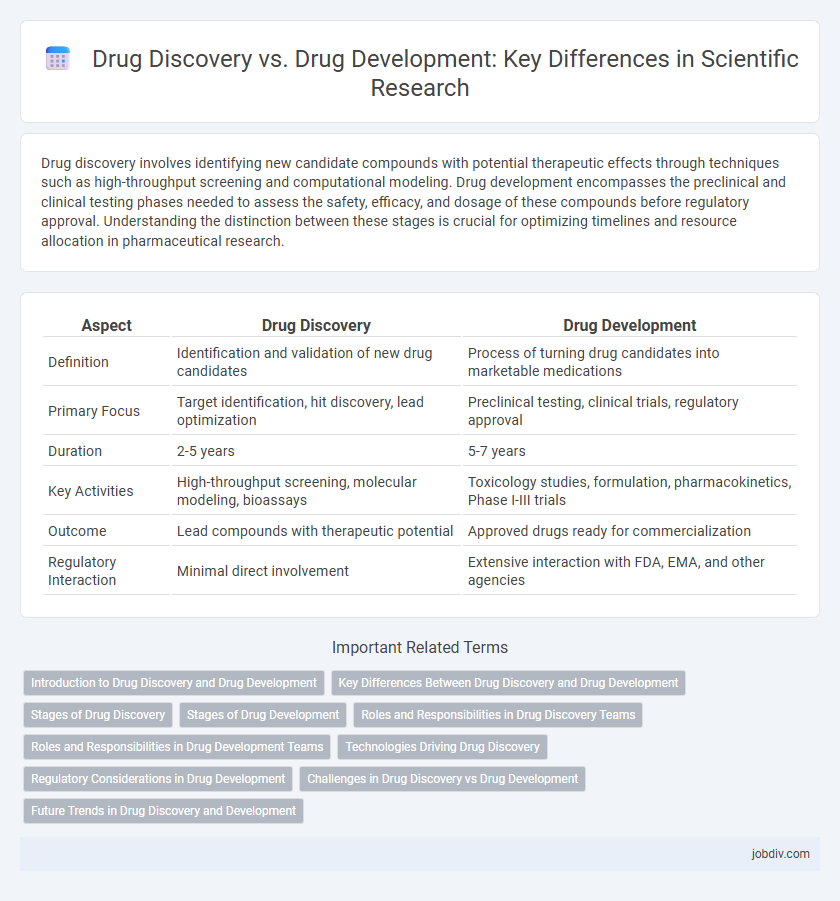Drug discovery involves identifying new candidate compounds with potential therapeutic effects through techniques such as high-throughput screening and computational modeling. Drug development encompasses the preclinical and clinical testing phases needed to assess the safety, efficacy, and dosage of these compounds before regulatory approval. Understanding the distinction between these stages is crucial for optimizing timelines and resource allocation in pharmaceutical research.
Table of Comparison
| Aspect | Drug Discovery | Drug Development |
|---|---|---|
| Definition | Identification and validation of new drug candidates | Process of turning drug candidates into marketable medications |
| Primary Focus | Target identification, hit discovery, lead optimization | Preclinical testing, clinical trials, regulatory approval |
| Duration | 2-5 years | 5-7 years |
| Key Activities | High-throughput screening, molecular modeling, bioassays | Toxicology studies, formulation, pharmacokinetics, Phase I-III trials |
| Outcome | Lead compounds with therapeutic potential | Approved drugs ready for commercialization |
| Regulatory Interaction | Minimal direct involvement | Extensive interaction with FDA, EMA, and other agencies |
Introduction to Drug Discovery and Drug Development
Drug discovery involves identifying potential drug candidates through target validation, high-throughput screening, and lead optimization to treat specific diseases. Drug development encompasses preclinical testing, clinical trials (phases I-III), regulatory approval, and post-market surveillance to ensure safety and efficacy. Together, these processes accelerate the transformation of molecular compounds into viable therapeutic agents.
Key Differences Between Drug Discovery and Drug Development
Drug discovery involves identifying potential drug candidates through screening, target validation, and lead compound optimization, focusing on molecular interactions and biological efficacy. Drug development encompasses preclinical testing, clinical trials, regulatory approval, and manufacturing, emphasizing safety, pharmacokinetics, and large-scale production. The key difference lies in discovery's goal to find promising compounds, whereas development ensures those compounds become safe, effective medications for patient use.
Stages of Drug Discovery
Drug discovery encompasses the initial stages of identifying potential therapeutic compounds, including target identification, compound screening, and lead optimization. This phase relies heavily on techniques like high-throughput screening, molecular modeling, and bioassays to evaluate drug efficacy and safety profiles. Successful drug candidates from this stage advance to drug development, which involves preclinical testing, regulatory approval, and clinical trials.
Stages of Drug Development
Drug development encompasses multiple stages, including preclinical testing, clinical trials (Phase I-III), regulatory review, and post-marketing surveillance, each critical for ensuring drug safety and efficacy. Preclinical studies involve in vitro and in vivo experiments to assess pharmacodynamics, pharmacokinetics, and toxicity, while clinical phases progressively evaluate safety, optimal dosing, and therapeutic effectiveness in human subjects. Regulatory agencies like the FDA or EMA oversee the approval process, requiring comprehensive data from each development stage to confirm that a drug meets stringent standards before market authorization.
Roles and Responsibilities in Drug Discovery Teams
Drug discovery teams primarily focus on identifying novel therapeutic targets and screening potential drug candidates using high-throughput screening and computational modeling techniques. Their roles include target validation, lead compound identification, and early-stage optimization to ensure efficacy and safety profiles align with therapeutic goals. Collaboration with medicinal chemists, biologists, and pharmacologists is essential to refine candidates before transitioning to drug development phases.
Roles and Responsibilities in Drug Development Teams
Drug discovery teams concentrate on identifying and validating novel drug targets, optimizing lead compounds, and conducting early-stage pharmacological research. Drug development teams manage clinical trials, regulatory compliance, formulation optimization, and scale-up manufacturing processes. Collaboration between medicinal chemists, pharmacologists, clinical researchers, and regulatory affairs specialists ensures the transition from candidate identification to market approval.
Technologies Driving Drug Discovery
High-throughput screening (HTS), artificial intelligence (AI), and molecular modeling are revolutionizing drug discovery by enabling rapid identification and optimization of lead compounds. Next-generation sequencing and CRISPR-based functional genomics provide precise target validation, accelerating the selection of drug candidates. These advanced technologies drastically reduce early-stage failure rates and enhance the efficiency of the drug discovery pipeline compared to traditional methods.
Regulatory Considerations in Drug Development
Regulatory considerations in drug development encompass stringent requirements for preclinical and clinical trial phases to ensure safety, efficacy, and quality compliance as mandated by agencies like the FDA, EMA, and ICH guidelines. Documentation such as Investigational New Drug (IND) applications and New Drug Applications (NDA) play critical roles in gaining approvals at different stages. Continuous regulatory oversight throughout drug development ensures adherence to Good Laboratory Practice (GLP), Good Clinical Practice (GCP), and Good Manufacturing Practice (GMP) standards, minimizing risks before market authorization.
Challenges in Drug Discovery vs Drug Development
Drug discovery faces challenges such as identifying viable therapeutic targets and screening vast compound libraries for efficacy and safety, often complicated by high attrition rates in early-stage research. Drug development encounters obstacles including optimizing pharmacokinetics, ensuring regulatory compliance, and managing the extensive timelines and costs associated with clinical trials. Both phases require rigorous validation to transition compounds from laboratory success to effective, marketable treatments.
Future Trends in Drug Discovery and Development
Emerging technologies such as artificial intelligence, machine learning, and CRISPR gene editing are revolutionizing the future of drug discovery by enabling rapid identification of novel drug candidates and personalized medicine approaches. Advanced computational models and high-throughput screening are expected to streamline the drug development pipeline, reducing time and costs while improving success rates in clinical trials. Integration of multi-omics data and real-world evidence is driving precision therapeutics, transforming both discovery and development phases with data-driven decision-making.
Drug Discovery vs Drug Development Infographic

 jobdiv.com
jobdiv.com